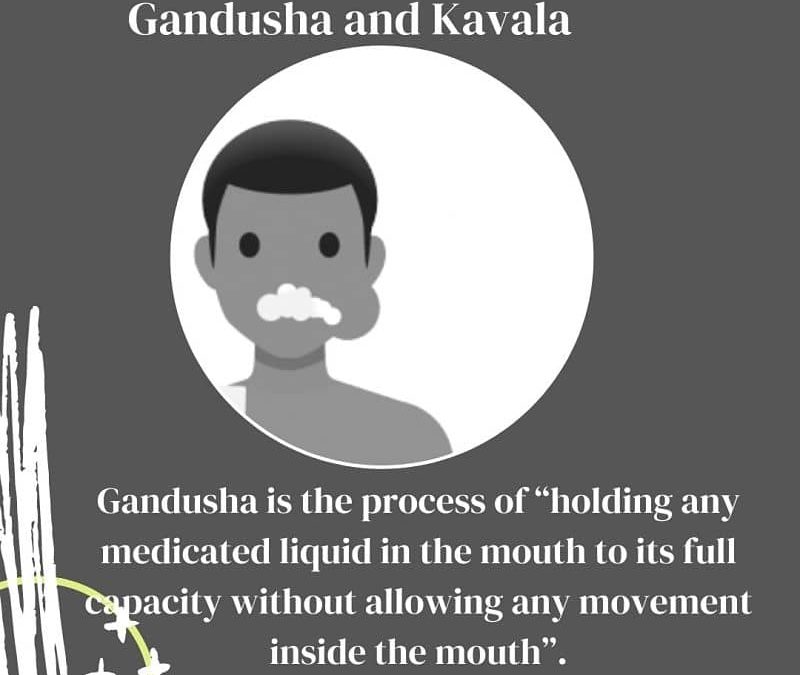Gandusha and Kavala- Ayurveda Therapy to keep Oral Cavity Healthy
Our oral cavity is is constantly exposed to many risk factors in day-to-day life. Contaminated foods-drinks-air, junk food habits and addictions like tobacco chewing, smoking, alcohol intake, soft drinks, irregular food habits, mental stress etc. result in accumulation of toxins in the oral cavity and cause bacterial invasion leading to bad oral hygiene. The problems regarding bad oral hygiene are progressively increased and finally lead to increased risk of oral disorders. Hence in order to avoid the occurrence of diseases, and to keep the oral cavity healthy, Ayurveda recommends kavala and gandusa therapy.
Gandusha is explained as one of the routine procedure under the context of daily regimens (dinacharya) for the maintenance of good oral health. It can be done in both healthy and diseased persons. In a healthy person it can be done by using plain sesame oil (tila taila). For a diseased person it can be done by using different medicated liquids or decoctions depending upon the condition of the disease and desired therapeutic effects.
Gandusha is the process of “holding any medicated liquid in the mouth to its full capacity for a specific time without allowing any movement inside the mouth”. Gandūsha is done with the unctuous substances or fats (sneha) like oils (tailādi) or ghee (grita) etc., milk (Kshīra), honey (kshoudra), honey-water (madhūdaka), meat soup (māmsarasa), wine (madhya), urine of animals (mūtra), sour liquids (āmla), wash of grains fermented by keeping overnight (dhānyāmla), herbal decoctions (kashāya) or warm water (ushnodaka) etc. according to the doshās.
In Kavala, Medicated fluids are kept in the mouth in less quantity and asked to rotate in the mouth for a specific time and then expelled out. According to Sarangadhara, Kalka (medicated bolus) drugs are used in kavala and liquids are used in gandusha.
Types of Gandusha
According to different Ayurvedic Āchāryās,
Snehana (oleating): This type of Gandusha is effective in correcting the imbalance of the Vāta dosha in the mouth.
Shamana (palliating): This type of Gandusha is beneficial for the alleviation of morbid Pitta dosha in the buccal cavity. As the name itself suggests, this type of Gandūsha reduces the irritation due to Pitta dosha and has soothing effect in the buccal cavity.
Samshodhana (purificatory): It is purificatory type of Gandusha. This type of Gandusha induces excessive oro-pharyngeal secretions. It is capable of eliminating the morbid Kapha dosha along with the oro- pharyngeal secretions in the oral cavity and hence the name Shodhana Gandūuha. So, it is useful in Kaphaja diseases of the mouth (kaphaja mukha roga) i.e. diseases associated with excessive salivation and stickiness in the mouth.
Ropana (healing): It is healing type of Gandusha. This type of Gandūsha promotes healing of ulcers in the mouth and hence useful in case of mouth ulcers (mukha vranās).
Kashaya and Sneha Gandusa: The ingredients of Kashāya Gandusha neutralize sugar residues immediately and it stops food supply to the bacteria’s survival and growth. In this way it will help to remove bacterial load from the oral cavity and regain of oral health. Sneha Gandūsha contains mainly lipid- soluble ingredients which will remove all the lipid-based toxins from the mouth.
The procedure of Gandusha and Kavala
The individual should be made to sit comfortably in erect posture in devoid of breeze in sunlight. His shoulders, throat, cheeks and forehead should be massaged and fomented. He should be asked to hold the medicated liquid in his mouth without doing any movement inside with concentrated mind and face slightly lifted up. He should be advised not to drink the liquid and hold it until the mouth gets filled with oro-pharyngeal secretions (kapha) and watery discharge (jalasrāva) appears from the nose (nāsa) and the eyes (netra) – for gandusa. While for kavala, the same medicine is slowly moved in the oral cavity.
Benefits of a good gandusa and kavala
- Alleviation of illness or disease
- Freshness of the mouth or feeling of contentment
- Clarity of the oral cavity
- Feeling of lightness in the mouth
- Clarity or normal functioning of the sense organs.
